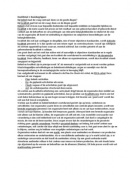International Business Strategy (MSc) – Literature
Contents
PENG & PLEGGENKUHLE-MILES: “CURRENT DEBATES IN GLOBAL STRATEGY” (W1) ..........................2
LE & KROLL: CEO INTERNATIONAL EXPERIENCE: EFFECTS ON STRATEGIC CHANGE AND FIRM
PERFORMANCE (W3).........................................................................................................................4
MAITLAND & SAMMARTINO – MANAGERIAL COGNITION AND INTERNATIONALIZATION (W3)........6
TONG, REUER & PENG – INTERNATIONAL JOINT VENTURES AND THE VALUE OF GROWTH OPTIONS
(W5)..................................................................................................................................................9
CHOI & CONTRACTOR – CHOOSING AN APPROPRIATE ALLIANCE GOVERNANCE MODE: THE ROLE OF
INSTITUTIONAL, CULTURAL AND GEOGRAPHICAL DISTANCE IN INTERNATIONAL RESEARCH &
DEVELOPMENT (R&D) COLLABORATION (W5).................................................................................10
UL HAQ, DROGENDIJK & HOLM – ATTENTION IN WORDS, NOT IN DEEDS: EFFECTS OF ATTENTION
DISSONANCE ON HEADQUARTERS-SUBSIDIARY COMMUNICATION IN MULTINATIONAL
CORPORATIONS (W6)......................................................................................................................12
EGELHOFF, WOLF & ADZIC – DESIGNING MATRIX STRUCTURES TO FIT MNC STRATEGY (W6).........16
,Peng & Pleggenkuhle-Miles: “Current debates in global strategy” (W1)
Four debates:
1. cultural vs. institutional distance
2. global vs. regional geographic diversification
3. convergence vs. divergence in corporate governance
4. domestic vs. overseas corporate social responsibility
Underlying theme connecting these four diverse debates is the institution-based view of global
strategy.
Defining ‘global strategy’
Views on global strategy:
1. Global strategy is one particular form of multinational enterprise (MNE) strategy that treats
countries around the world as a common, global marketplace.
2. Global strategy is treated as “international strategic management”.
3. Global strategy is the strategy of firms around the globe, which is firms’ theory about how to
compete successfully. The paper follows the third view.
Theoretical Underpinning: Institution-based View
All works associated with the external environment can be labeled an institution-based
perspective. Institutions are the rules of the game. International firms must know and be aware
of the formal and informal rules governing those countries they are invested in. The institution-
based view suggests that firm strategies are enabled and constrained by the different rules of
the game around the world.
The formal institutions may appear to be converging, as common legislation or governing
systems are adopted. Informal institutions at work may not actually implement these
convergence mechanisms.
Cultural vs. Institutional Distance
A new view argues that global strategy is fundamentally shaped (at least in part) by the formal
and informal institutions commonly known as the rules of the game. Culture is defined as a
cumulative of societal values, beliefs, norms and behavioral patterns.
Cultural distance: the study of principal differences in national cultures between the home
countries of MNEs and the host countries of their operations.
Institutional distance: encompasses cultural distances as well as additional factors, such as
regulatory differences, normative pressures and cognitive identification.
Increased cultural distance may lead to higher levels of complexity and uncertainty for
managerial decision-making. Despite these findings, cultural distance has its critics:
1. There are a number of findings inconsistent with the hypothesis that joint ventures between
local firms outperform those between local firms and a foreign firm.
2. The view exists that cultural distance is just one of many factors to consider when firms go
abroad.
3. A meta-analysis (Tihanyi, 2005) found a near zero relationship between cultural distance and
three variables: entry mode choice, international diversification and MNE performance.
4. These critics generally look beyond the Hofstede dimensions towards an institutional
construct with the argument that cultural distance can be complemented by institutional
distance.
It remains to be seen which measure – cultural- or institutional distance – is more appropriate
for explaining actual and potential variance in firm characteristics and performance.
Global vs. Regional Geographic Diversification
Three concepts by Perlmutter:
1. Ethnocentric
, 2. Polycentric
3. Geocentric
Much of the international activity of MNEs is conducted at the intra-regional rather than the
inter-regional level. Many MNE operations are organized at the regional level as opposed to the
global level. The regional concentration of MNE activity is more reflective of GDP and trade than
of a distinctive MNE strategy. The data supporting the ‘regional’ view only capture a snapshot in
time. There are multiple ways to define a region.
Convergence vs. Divergence in Corporate Governance
Issue: whether economic ideology or national culture drives societal values. Those who believe
that economic ideology drives values tend to follow the convergence perspective, whereas those
who argue that national culture drives values often follow the divergence perspective.
A lively debate within the corporate governance literature questions whether corporate
governance is converging or diverging globally.
Voluntary adoption of key international standards comes from the inherent threat of market
compliance pressures.
Cross-listed firms are often viewed as carriers of Anglo-American corporate governance norms
and values around the world.
Corporate governance: the structure of rights and responsibilities among the parties with a
stake in the firm.
While convergence advocates note the similarity of governance regulations being implemented
around the globe, divergence advocates maintain that, while it is possible to export form US/UK-
style regulations to other countries, it is much more difficult to transplant the informal norms,
values and traditions around the world without changing the underlying structure of
concentrated ownership and control.
Crossvergence: neither of these views adequately explains the dynamic interaction at play.
Domestic vs. Overseas Corporate Social Responsibility
Two viewpoints of the responsibility of the firm:
1. Managers should make decisions that maximize the wealth of the firm’s equity holders.
2. Because corporations draw resources from society, they have a duty to society that goes
beyond simply maximizing the wealth of equity holders.
How can firms balance the often-conflicting demands between domestic and overseas CSR?
Contents
PENG & PLEGGENKUHLE-MILES: “CURRENT DEBATES IN GLOBAL STRATEGY” (W1) ..........................2
LE & KROLL: CEO INTERNATIONAL EXPERIENCE: EFFECTS ON STRATEGIC CHANGE AND FIRM
PERFORMANCE (W3).........................................................................................................................4
MAITLAND & SAMMARTINO – MANAGERIAL COGNITION AND INTERNATIONALIZATION (W3)........6
TONG, REUER & PENG – INTERNATIONAL JOINT VENTURES AND THE VALUE OF GROWTH OPTIONS
(W5)..................................................................................................................................................9
CHOI & CONTRACTOR – CHOOSING AN APPROPRIATE ALLIANCE GOVERNANCE MODE: THE ROLE OF
INSTITUTIONAL, CULTURAL AND GEOGRAPHICAL DISTANCE IN INTERNATIONAL RESEARCH &
DEVELOPMENT (R&D) COLLABORATION (W5).................................................................................10
UL HAQ, DROGENDIJK & HOLM – ATTENTION IN WORDS, NOT IN DEEDS: EFFECTS OF ATTENTION
DISSONANCE ON HEADQUARTERS-SUBSIDIARY COMMUNICATION IN MULTINATIONAL
CORPORATIONS (W6)......................................................................................................................12
EGELHOFF, WOLF & ADZIC – DESIGNING MATRIX STRUCTURES TO FIT MNC STRATEGY (W6).........16
,Peng & Pleggenkuhle-Miles: “Current debates in global strategy” (W1)
Four debates:
1. cultural vs. institutional distance
2. global vs. regional geographic diversification
3. convergence vs. divergence in corporate governance
4. domestic vs. overseas corporate social responsibility
Underlying theme connecting these four diverse debates is the institution-based view of global
strategy.
Defining ‘global strategy’
Views on global strategy:
1. Global strategy is one particular form of multinational enterprise (MNE) strategy that treats
countries around the world as a common, global marketplace.
2. Global strategy is treated as “international strategic management”.
3. Global strategy is the strategy of firms around the globe, which is firms’ theory about how to
compete successfully. The paper follows the third view.
Theoretical Underpinning: Institution-based View
All works associated with the external environment can be labeled an institution-based
perspective. Institutions are the rules of the game. International firms must know and be aware
of the formal and informal rules governing those countries they are invested in. The institution-
based view suggests that firm strategies are enabled and constrained by the different rules of
the game around the world.
The formal institutions may appear to be converging, as common legislation or governing
systems are adopted. Informal institutions at work may not actually implement these
convergence mechanisms.
Cultural vs. Institutional Distance
A new view argues that global strategy is fundamentally shaped (at least in part) by the formal
and informal institutions commonly known as the rules of the game. Culture is defined as a
cumulative of societal values, beliefs, norms and behavioral patterns.
Cultural distance: the study of principal differences in national cultures between the home
countries of MNEs and the host countries of their operations.
Institutional distance: encompasses cultural distances as well as additional factors, such as
regulatory differences, normative pressures and cognitive identification.
Increased cultural distance may lead to higher levels of complexity and uncertainty for
managerial decision-making. Despite these findings, cultural distance has its critics:
1. There are a number of findings inconsistent with the hypothesis that joint ventures between
local firms outperform those between local firms and a foreign firm.
2. The view exists that cultural distance is just one of many factors to consider when firms go
abroad.
3. A meta-analysis (Tihanyi, 2005) found a near zero relationship between cultural distance and
three variables: entry mode choice, international diversification and MNE performance.
4. These critics generally look beyond the Hofstede dimensions towards an institutional
construct with the argument that cultural distance can be complemented by institutional
distance.
It remains to be seen which measure – cultural- or institutional distance – is more appropriate
for explaining actual and potential variance in firm characteristics and performance.
Global vs. Regional Geographic Diversification
Three concepts by Perlmutter:
1. Ethnocentric
, 2. Polycentric
3. Geocentric
Much of the international activity of MNEs is conducted at the intra-regional rather than the
inter-regional level. Many MNE operations are organized at the regional level as opposed to the
global level. The regional concentration of MNE activity is more reflective of GDP and trade than
of a distinctive MNE strategy. The data supporting the ‘regional’ view only capture a snapshot in
time. There are multiple ways to define a region.
Convergence vs. Divergence in Corporate Governance
Issue: whether economic ideology or national culture drives societal values. Those who believe
that economic ideology drives values tend to follow the convergence perspective, whereas those
who argue that national culture drives values often follow the divergence perspective.
A lively debate within the corporate governance literature questions whether corporate
governance is converging or diverging globally.
Voluntary adoption of key international standards comes from the inherent threat of market
compliance pressures.
Cross-listed firms are often viewed as carriers of Anglo-American corporate governance norms
and values around the world.
Corporate governance: the structure of rights and responsibilities among the parties with a
stake in the firm.
While convergence advocates note the similarity of governance regulations being implemented
around the globe, divergence advocates maintain that, while it is possible to export form US/UK-
style regulations to other countries, it is much more difficult to transplant the informal norms,
values and traditions around the world without changing the underlying structure of
concentrated ownership and control.
Crossvergence: neither of these views adequately explains the dynamic interaction at play.
Domestic vs. Overseas Corporate Social Responsibility
Two viewpoints of the responsibility of the firm:
1. Managers should make decisions that maximize the wealth of the firm’s equity holders.
2. Because corporations draw resources from society, they have a duty to society that goes
beyond simply maximizing the wealth of equity holders.
How can firms balance the often-conflicting demands between domestic and overseas CSR?










